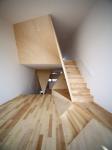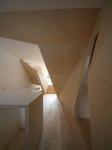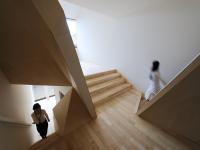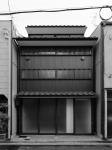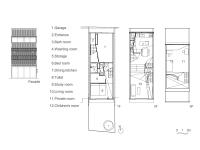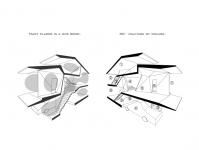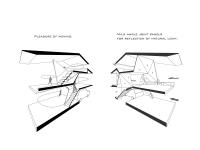This is a residential house located on a narrow site in the centre of Kyoto, the old capital of Japan. The area is lined with traditional wooden townhouses. While inheriting the advantages of townhouses, we intended to overcome their drawbacks and create a comfortable and enjoyable space.
The most characteristic feature of this house is the polyhedral form of the partition walls. They are not made by intuition but are based on logical concepts and perform multiple functions.
First, the partition walls, normally extended in the vertical and horizontal directions, have multidimensionality and loosely connect the rooms on the three floors. The space thus created is one continuous room with dynamic nuances: it is simultaneously spacious and heterogeneous.
Second, the partition walls serve as reflectors of natural light. They softly reflect the natural light coming from both the north and south sides and bring it to the otherwise dark interior of the building.
Finally, the partition walls blur the boundary between architecture and furniture, thus stimulating perception and behaviour. Melt into floors and ceilings, the plywood-finished walls offer enjoyable experiences of touching and passing. The house as a whole is a machine for living, like playground equipment.
Because of the landscape regulations and the physical context of the neighbourhood, we inherited the traditional form and composition of townhouses.
But at the same time, this house overcome the negative aspects of townhouses. The wooden structure of townhouses cannot afford to have large openings on the short sides of the building as well as on floors. Consequently, the interior is dark and communications of people are limited to the horizontal direction. In this project, it is the steel rigid frame and the polyhedral partition walls that enable to overcome the drawbacks of typical townhouses. Large openings on the walls and the floors, along with the partitions, allow natural light to diffuse multidirectionally, and encourage three dimensional communications and movements.
Freed from the constraints of the old system, occupants can have various relations with each other and place, and a new lifestyle in the historical area of Kyoto emerges.
2009
2010
Location / Kyoto, Japan
Use / Residence
Site area / 78.68 m2
Building area / 44.00 m2
Gross area / 104.66 m2 (1F: 44.00 m2, 2F: 44.00 m2 , 2F: 16.66 m2 )
Building coverage ratio / 55.92%
Floor area ratio / 133.02%
Building scale / 3 stories
Parking capacity / 1 parking space
Structure system / steel structure
Period of design / 12,2008 - 9,2009
Period of construction / 9,2009 - 04,2010
Exterior finishing /
roof / Kawara Japanese Light Weight Roof,
exterior wall / galvanized and aluminum coated steel sheet siding
opening / aluminum sash steel sash
exterior/ concrete
Interior finishing /
Living room, Dining room, Kitchen: floor / maple flooring, t=15mm or
wall / Japanese linden plywood panel t=5.5mm,plasterboard, t=12.5mm, emulsion paint finish
ceiling / plasterboard, t=9.5mm, emulsion paint finish
Bedroom, Childroom: floor / maple flooring, t=15mm
wall / Japanese linden plywood panel t=5.5mm,plasterboard, t=12.5mm, emulsion paint finish
ceiling / plasterboard, t=9.5mm, emulsion paint finish
Washroom: floor / polyvinyl chloride flooring t=2.5mm
wall / waterproof plasterboard, t=12.5mm, emulsion paint finish
ceiling / plasterboard, t=9.5mm, emulsion paint finish
storage: floor / polyvinyl chloride flooring t=2.5mm
wall / plasterboard, t=12.5mm, emulsion paint finish
ceiling / plasterboard, t=9.5mm, emulsion paint finish
Bathroom: Unit system
ALPHAVILLE
Kentaro Takeguchi + Asako Yamamoto
Tomohisa Koike(Associate Architect)
Kazuo Takeguchi(Structural Engineer)

